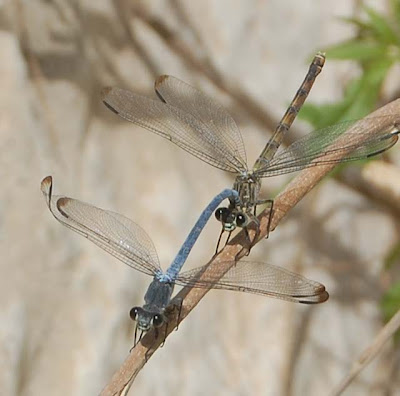
Much work had been done on the area.. to make it both visitor and nature friendly. it is now officially a nature reserve: fishing and other interference with the nature is prohibited. (Our boys reluctantly had to deposit their home made nets). Chemical toilets are now available near the start of the hike and specific areas for barbecues set aside.. campfires now not permitted along the trails for obvious reasons- not so much an issue now but will be in the summer as vegetation dries out. Their favourite swimming pool along the watercourse was mostly filled with gravel, this I am sure for safety reasons since youngsters would jump in it from a rock.. no more! The park authorities no doubt want to prevent accidents. Still, the boys did find some places deep enough to have water fun. The water was very cold but after lying in the midday sun with caps over faces they soon warmed up. Temps were in the upper 80s if not higher.

Below: an unfamiliar plant- I do not remember seeing this at all in our summer visits.. and in fact did not see it on this. Akiva found it on his way to the top and captured this exquisite shot.



As for birds : graceful warblers about and allowing quite close approach, they were busy foraging for their families no doubt. One flittered by me almost like a butterfly but was too fast for me to get a shot. Tristram's starlings were heard, (crag?) martins darted about between the rock faces. We noticed a large raptor hovering over the desert on our approach to the wadi, had a terminal tail band.. tentatively IDd as a honey buzzard.
Back to our neighbourhood:
Thursday 1st April:
Headed up to quarry today. On approach to quarry heard repeated chukar partridge calls.. we saw one on top of a rock on a great pile of rocks north of the trail (where we've seen little owl) ..just standing there and calling harsh short call many times.. another way up the hill, top of first quarry to the south doing same thing. Yet another somewhere on south facing slopes beyond the pines.. seems to me cocks announcing their territories.
As we walked into main quarry area I whistled and within seconds heard a Tristram's starling whistle. There were four birds sticking together in two pairs, flying about the quarry and perching on the rocky ledges opposite.
Then a magnificent sparrowhawk, from size I suspect a hen, flew in circles over us and the quarry.
Other birds about included blackbird, in song as twilight fell, check w Ak
Two gazelle just down from the north ridge.
Saturday 3rd April: The bee-eaters are back! A group of 9 calling and flying over valley road as we descended at about 6.30 p.m. and then, as we passed by look-out corner, we watched a group of 15 or so hunted between the pistacio orchard and the cistern.
Also about: jackdaws, hooded crows, blackbirds, greenfinches, graceful warblers, swifts. Chukars(?) Hyraxes very vocal and active.


No comments:
Post a Comment